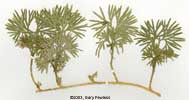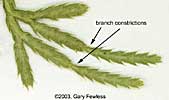
Ferns and Fern Allies of Wisconsin
|
This species and D. digitatum have conspicuously broad, flattened branches (1.8-4 mm wide) that are very distinctive and unlikely to be confused with the other species of this family. The branches have conspicuous constrictions at the juncture between consecutive years growth (D. digitatum lacks such constrictions). The branches are green and often shiny above and paler green below. Spores are borne in strobili on conspicuous peduncles and the tips of the strobili are not sterile (tips are often sterile in D. digitatum). The upright shoots of D. complanatum are reported to range from 8-44 cm tall, but most are less than 20 cm in my experience and may look even shorter if the bases arise out of a deep layer of dead leaves. Diphasiastrum complanatum is a northern species, extending from Alaska across all the Canadian provinces and dipping south to Washington, Idaho and Montana in the west and to the northern portions of Minnesota, Wisconsin, Michigan, New York and New hampshire, Maine and Connecticut in the east. In Wisconsin it is limited to the northern portions, with most current populations from Marinette and Oconto Counties and north in the east and from Taylor and Burnett north in the west. Habitats appear to be forests (and openings) a bit drier than those of D. digitatum.
|
|



